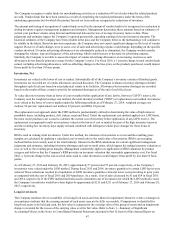Albertsons 2016 Annual Report Download - page 56
Download and view the complete annual report
Please find page 56 of the 2016 Albertsons annual report below. You can navigate through the pages in the report by either clicking on the pages listed below, or by using the keyword search tool below to find specific information within the annual report.
54
CONTRACTUAL OBLIGATIONS
The following table represents the Company’s significant contractual obligations as of February 27, 2016:
Payments Due Per Period
Total Fiscal
2017 Fiscal
2018-2019 Fiscal
2020-2021 Thereafter
Contractual obligations(1)(2):
Long-term debt(3) $ 2,347 $ 102 $ — $ 1,495 $ 750
Interest on long-term debt(4) 575 125 249 133 68
Operating leases(5) 642 126 210 140 166
Capital leases(6) 300 41 77 65 117
Purchase obligations(7) 291 206 74 11 —
Self-insurance obligations(8) 101 31 34 15 21
Total contractual obligations $ 4,256 $ 631 $ 644 $ 1,859 $ 1,122
(1) Contractual obligations payments due per period presented here exclude the Company’s discretionary funding of its pension and
required funding of its postretirement benefit obligations, which totaled $40 for fiscal 2016, and multiemployer pension plan
contributions, which totaled $43 for fiscal 2016, because the timing of future payments beyond fiscal 2017 cannot be reasonably
determined. Pension and postretirement benefit obligations were $585 as of February 27, 2016. The Company expects to contribute
$30 to $35 to pension and postretirement benefit plans during fiscal 2017, but is not required to make minimum pension contributions.
(2) Unrecognized tax benefits, which totaled $70 as of February 27, 2016, were excluded from the contractual obligations table because
an estimate of the timing of future tax settlements cannot be reasonably determined.
(3) Long-term debt amounts exclude any original issue discounts and deferred financing costs. Long-term debt payments due for fiscal
2017 include the Excess Cash Flow prepayment required under the provisions of the Secured Term Loan Facility. Long-term debt
payments due per period for fiscal 2018 through thereafter exclude any Excess Cash Flow prepayments required under the provisions
of the Secured Term Loan Facility because the amount of future prepayment amounts, if any, are not reasonably estimable as
of February 27, 2016.
(4) Amounts include contractual interest payments using the interest rate as of February 27, 2016 applicable to the Company’s variable
interest debt instruments (including variable interest rates under the Secured Term Loan Facility that have been swapped to fixed
interest rates) and stated fixed rates for all other debt instruments.
(5) Represents the minimum rents payable under operating leases, excluding common area maintenance, insurance or tax payments, for
which the Company is also obligated, offset by minimum subtenant rentals of $44, $16, $21, $7 and $1, respectively.
(6) Represents the minimum payments under capital leases, excluding common area maintenance, insurance or tax payments, for which
the Company is also obligated, offset by minimum subtenant rentals of $15, $3, $5, $2 and $5, respectively.
(7) The Company’s purchase obligations include various obligations that have annual purchase commitments of $1 or greater. As of
February 27, 2016, future purchase obligations existed that primarily related to fixed asset and information technology commitments.
In addition, in the ordinary course of business, the Company enters into supply contracts to purchase product for resale to consumers
and to Wholesale customers, which are typically of a short-term nature with limited or no purchase commitments. The majority of the
Company's supply contracts are short-term in nature and relate to fixed assets, information technology and contracts to purchase
product for resale. These supply contracts typically include either volume commitments or fixed expiration dates, termination
provisions and other standard contractual considerations. The supply contracts that are cancelable have not been included above.
(8) The Company’s insurance reserves include the undiscounted obligations related to workers’ compensation, general and automobile
liabilities at the estimated ultimate cost of reported claims and claims incurred but not yet reported and related expenses.
ITEM 7A. QUANTITATIVE AND QUALITATIVE DISCLOSURES ABOUT MARKET RISK
The Company does not use financial instruments or derivatives for any trading or other speculative purposes.
Interest Rate Risk
The Company is exposed to market pricing risk consisting of interest rate risk related to debt obligations and notes receivable
outstanding. Interest rate risk is managed through the strategic use of fixed and variable rate debt and, to a limited extent,
derivative financial instruments. Variable interest rate debt (bank loans and revolving lines of credit) is utilized to help maintain
liquidity and finance business operations. Variable rate borrowings consist primarily of LIBOR and prime rate based loans,
some of which contain interest rate floors. Long-term debt with fixed interest rates is used to assist in managing debt maturities
and to diversify sources of debt capital. Changes in interest rates related to debt with fixed interest rates do not have an impact
upon future results of operations and cash flow while outstanding; however, if additional debt issuances are required to fund
fixed rate debt maturities, future results of operations or cash flows may be impacted.
























